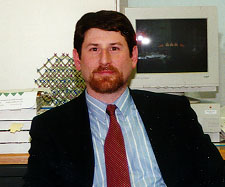

Department of Applied Physics and Applied Mathematics (APAM)
Professor (Optical and Solid State Physics, and Materials Science)
Member, Columbia Nanoinitiative
S.B., Massachusetts Institute of Technology, 1972
Ph.D., 1977
Biography:
IRVING HERMAN graduated with S.B. and Ph.D. degrees in physics from M.I.T. in 1972 and 1977. From 1977-1986 he was a member and section leader in O-group within the Physics Department at the Lawrence Livermore National Laboratory, where he was engaged in research in laser isotope separation of deuterium and tritium, and the use of direct laser writing in thin film processing. In 1986, he joined the faculty of Columbia University, where he is now Edwin Howard Armstrong Professor of Applied Physics. From 2006-2012 he was chair of the Department of Applied Physics and Applied Mathematics, and became chair again from 2018-2021. From 1998-2010 he was Director of the Columbia Materials Research Science and Engineering Center (MRSEC) [The Center for Nanostructured Materials], and as part of this he led an extensive education outreach program. He was Director of the Columbia Optics and Quantum Electronics IGERT (Integrative Graduate Education and Research Traineeship program) from 2015-2019. He has overseen the Shared Materials Characterization Laboratory and was a member of the CNI Facilities Committee. He was a member of the Columbia Nanoinitiative (CNI) and the Columbia Materials Research Science and Engineering Center (MRSEC). He is a fellow of the American Physical Society and the Optical Society of America (now Optica).
His career at Columbia University has been one of diverse scholarly activities. His research activities have included the use of lasers to induce reactions at surfaces and for surface analysis, Raman microprobe spectroscopy, and topics in nanoscience and optics, including the assembly and analysis of nanocrystals and, more recently, van der Waals layers. In addition, he has written three books: a comprehensive monograph on optical diagnostics for thin film processing, a comprehensive textbook on physics of the human body, which is now in its second edition, and a semipopular book that tries to get adults to love math. He has developed three interactive seminars on ethics and presents them to students in his department, and has published on this subject. He has also examined the interwoven history of the Columbia University School of Engineering and Applied Science and events in New York City. (See the links on the home page for more information.)
Research Interests:
His research concentrates on the fundamental aspects and applications of laser interactions with matter and nanoscience. This includes properties of nanocrystals and films composed of nanocrystals, van der Waals layers, optical physics of the solid state, molecular and chemical physics, thin film processing, and optical spectroscopy.
One active area of research in his group is the study of the optical properties of semiconductor and metal oxide nanocrystals and how to assemble them into films by controlled evaporation and electrophoretic deposition (electric field directed assembly). He is also interested in van der Waals layers, including how to interface them with nanocrystals. His research includes Raman analysis of these nanocrystal and van der Waals layer assemblies, and understanding how they can be interesting components of device structures.
Another active area of research in his group is the use of optical spectroscopies to probe the physical and chemical events that occur in the thin film processing of microelectronic materials. These techniques are also called real-time optical diagnostics. He has used laser desorption and laser-induced fluorescence spectroscopies to probe the adlayers at the surface during novel types of plasma etching. These optical diagnostic studies also address the use of optical microprobe methods with tightly focused lasers to analyze patterned processes with high spatial resolution.
He is also interested in optical spectroscopy of semiconductors, and in particular in the effects of strain, confinement and temperature on these materials. He has studied phonons in materials like germanium-silicon alloys by Raman microprobe spectroscopy. He has also studied the optical spectroscopy of materials subjected to high pressure in diamond anvil cells, including thin films, multiple-quantum wells, and nanocrystals of novel light-emitting IV, III-V, and II-VI semiconductors by using photoluminescence and other optical methods. The goal of these studies was to understand the properties of electronic and optoelectronic materials better, in order to make more efficient use of them in applications and design of even better structures.
His research has also been in related areas of optical physics, including studies of optically pumped lasers, laser isotope separation, infrared laser multiple-photon dissociation, laser chemical modifications of surfaces, and optical microanalysis of semiconductors.
He has also developed a first year/second year undergraduate course on "Physics of the Human Body", has published the textbook "Physics of the Human Body" (Springer, Berlin-Heidelberg-New York, 2007) for this course, which has been translated from Brooklynese into Japanese and Greek, and a second edition in 2016, and has published the monograph "Optical Diagnostics for Thin Film Processing" (Academic Press, San Diego, 1996). He has published review articles on optical diagnostics, Raman scattering, optical thermometry, laser-assisted deposition, laser separation of tritium, direct laser writing, and laser isotope separation.
He recently published the semipopular math book "Coming Home to Math: Become Comfortable with the Numbers that Rule Your Life" (World Scientific, 2020).
Click to learn about Herman's Research and the American Presidency
To learn how Superman (and his foe) may have guided Herman's career path
Herman CV
Click for Herman's Google Scholar Citations
Click for Herman's Academic Tree
Click to learn about the former Columbia Optics and Quantum Electronics IGERT
Click to go to Herman's non-professional website